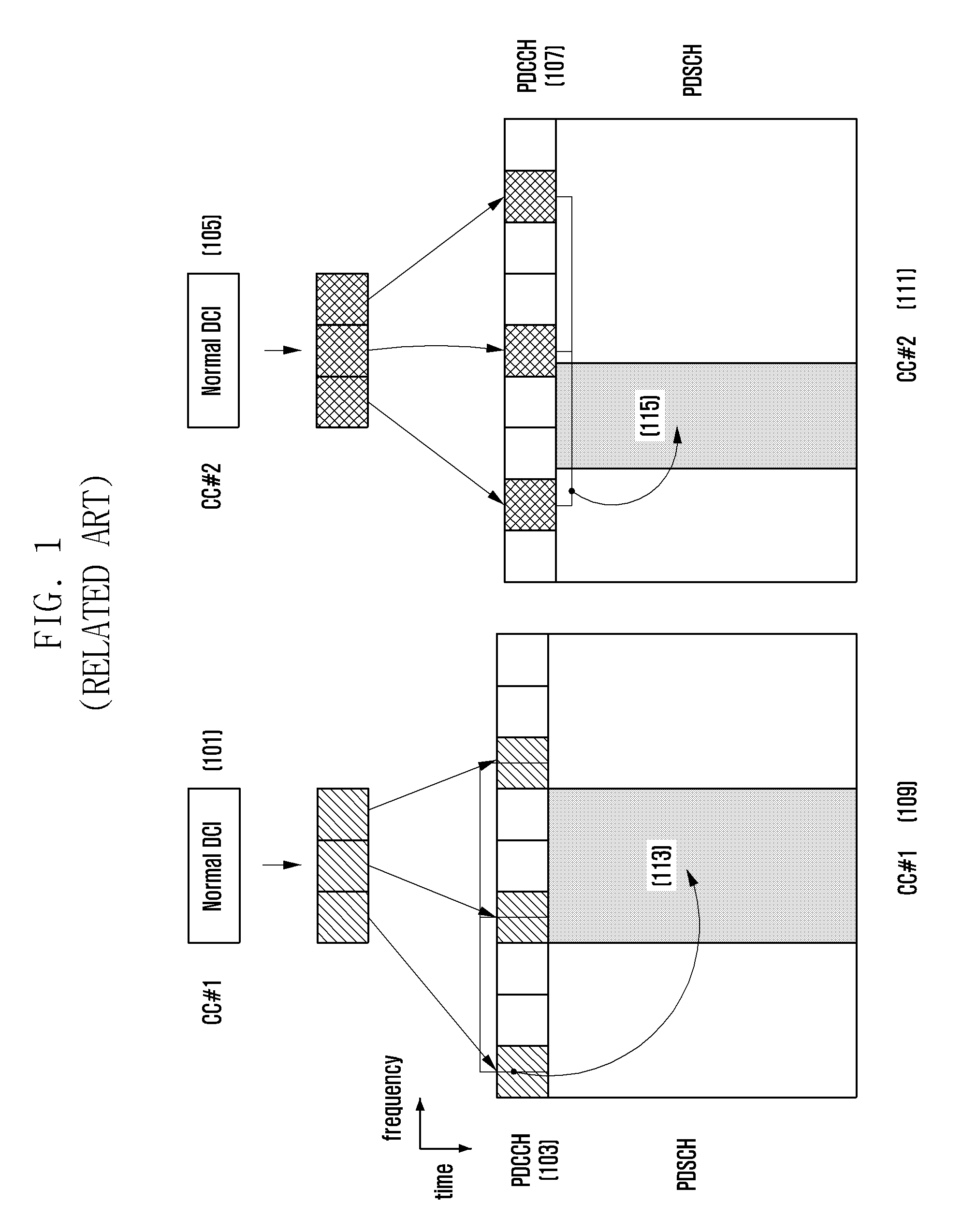Apparatus and method for defining physical channel transmit/receive timings and resource allocation in TDD communication system supporting carrier aggregation
a communication system and physical channel technology, applied in wireless communication, multiplex communication, synchronisation arrangement, etc., can solve problems such as difficulty in estimating satisfactory dci reception performan
- Summary
- Abstract
- Description
- Claims
- Application Information
AI Technical Summary
Benefits of technology
Problems solved by technology
Method used
Image
Examples
first exemplary embodiment
[0081]The first exemplary embodiment is directed to the case where the TDD uplink-downlink configurations of the aggregated carriers differ from each other in the TDD wireless communication system securing broadband resources through carrier aggregation. The timing relationship among the PDCCH, PDSCH, and PUCCH for transmitting uplink HARQ ACK / NACK that are related to downlink data transmission is described in association with rules 1 to 3.
[0082]FIG. 6 is a diagram illustrating a timing relationship between a PDSCH and an uplink HARQ ACK / NACK according to a first exemplary embodiment of the present invention. FIG. 6 is directed to an exemplary case where the PCell is configured with the TDD uplink-downlink configuration #3601 and the SCell is configuration with the TDD uplink-downlink configuration #4602 in the TDD system operating on the component carriers aggregated. Here, ‘D’ denotes a DL subframe, ‘U’ denotes an UL subframe, and ‘S’ denotes a special subframe.
[0083]Referring to ...
second exemplary embodiment
[0102]The second exemplary embodiment is directed to the case where the timing relationship among PDCCH, PDSCH, and PUCCH carrying the uplink HARQ ACK / NACK that are related to the downlink data transmission with rules 1 to 4 in the TDD wireless communication system securing broadband resource through carrier aggregation, especially when the TDD uplink-downlink configurations of the carriers differ from each other.
[0103]FIG. 7 is directed to the TDD system operating with two aggregated component carriers in which the PCell 701 is configured with the TDD uplink-downlink configuration #6 and the SCell 702 is configured with the TDD uplink-downlink configuration #2. The PCell's timing relationship among the PDCCH, PDSCH, and PUCCH that is defined in the legacy LTE system and the SCell's timing relationship among the PDCCH, PDSCH, and PUCCH that is defined in the legacy LTE system are expressed using solid link arrows. The start point of each solid line arrow denotes the DL subframe carr...
third exemplary embodiment
[0121]FIG. 8 is a diagram illustrating the timing relationship between the PDSCH and the uplink HARQ ACK / NACK according to the third exemplary embodiment of the present invention. FIG. 8 shows another exemplary embodiment to help understand the second exemplary embodiment more clearly, and is directed to the TDD system operating with two aggregated component carriers in which the PCell 801 is configured with the TDD uplink-downlink configuration #0 and the SCell 802 is configured with the TDD uplink-downlink configuration #2. By introducing rule 4 in addition to rules 1 to 3, the HARQ ACK / NACK transmission timings are distributed across the UL subframes within a radio frame as equally as possible.
[0122]In this case, the HARQ ACK / NACK transmission timing can be summarized as shown in Table 6. If the PDSCH transmitted by the eNB at the (n-j)th subframe, the UE transmits the uplink HARQ ACK / NACK corresponding to the PDSCH at nth subframe. Here, j is an element of a set J which is defin...
PUM
 Login to View More
Login to View More Abstract
Description
Claims
Application Information
 Login to View More
Login to View More - R&D
- Intellectual Property
- Life Sciences
- Materials
- Tech Scout
- Unparalleled Data Quality
- Higher Quality Content
- 60% Fewer Hallucinations
Browse by: Latest US Patents, China's latest patents, Technical Efficacy Thesaurus, Application Domain, Technology Topic, Popular Technical Reports.
© 2025 PatSnap. All rights reserved.Legal|Privacy policy|Modern Slavery Act Transparency Statement|Sitemap|About US| Contact US: help@patsnap.com



